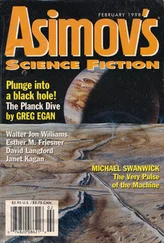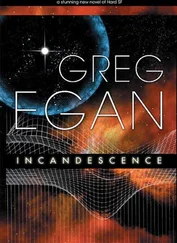Greg Egan - The Clockwork Rocket
Здесь есть возможность читать онлайн «Greg Egan - The Clockwork Rocket» весь текст электронной книги совершенно бесплатно (целиком полную версию без сокращений). В некоторых случаях можно слушать аудио, скачать через торрент в формате fb2 и присутствует краткое содержание. Жанр: Фантастика и фэнтези, на английском языке. Описание произведения, (предисловие) а так же отзывы посетителей доступны на портале библиотеки ЛибКат.
- Название:The Clockwork Rocket
- Автор:
- Жанр:
- Год:неизвестен
- ISBN:нет данных
- Рейтинг книги:3 / 5. Голосов: 1
-
Избранное:Добавить в избранное
- Отзывы:
-
Ваша оценка:
- 60
- 1
- 2
- 3
- 4
- 5
The Clockwork Rocket: краткое содержание, описание и аннотация
Предлагаем к чтению аннотацию, описание, краткое содержание или предисловие (зависит от того, что написал сам автор книги «The Clockwork Rocket»). Если вы не нашли необходимую информацию о книге — напишите в комментариях, мы постараемся отыскать её.
The Clockwork Rocket — читать онлайн бесплатно полную книгу (весь текст) целиком
Ниже представлен текст книги, разбитый по страницам. Система сохранения места последней прочитанной страницы, позволяет с удобством читать онлайн бесплатно книгу «The Clockwork Rocket», без необходимости каждый раз заново искать на чём Вы остановились. Поставьте закладку, и сможете в любой момент перейти на страницу, на которой закончили чтение.
Интервал:
Закладка:
v = κ/ν
Again, we can only use this formula with traditional units after applying the appropriate conversion factor:
v = ( v blue × κ)/ν
which, if we’re taking frequencies from the table above, becomes:
v = (78/144 × κ)/ν
The velocity we’ve been describing so far is a dimensionless quantity, related to the slope of a line tracing out the history of the light pulse on a space-time diagram. (The way we draw our diagrams, with the time axis vertical and the space axis horizontal, it’s actually the inverse of the slope.) Multiplying the dimensionless velocity by a further factor of 78, the speed of blue light in severances per pause, gives us the values in traditional units that appear in the table.
AFTERWORD
Much of what we know about the physics of our universe can be understood in terms of the fundamental symmetries of space-time. If you imagine any experiment that can be fully contained on a floating platform out in space, then orienting the platform in different directions or setting it in motion with different velocities will have no bearing on the outcome of the experiment. The particular directions in space and in time with which the platform is aligned make no difference.
However, in our universe the laws of physics distinguish very clearly between directions in space and directions in time. While you’re free to travel through space precisely due north if you wish, as you do so you will also be moving forward in time (as measured, say, by GMT). Expecting to be able to depart from Accra at 1:00:00.000 GMT and arrive at Greenwich to see the clocks showing exactly the same time—because you’d arranged to move “purely northwards” without any of that annoying progress through other people’s idea of time—is not just a tad optimistic, it’s physically impossible. “North” is a “space-like” direction (whatever else might be merely conventional about it), while “the future” is a “time-like” direction (however much it might differ from person to person traveling at relativistic speeds). No amount of relative motion can transform space-like into time-like or vice versa.
The underlying physics of Orthogonal comes from erasing that distinction between time and space—giving rise to an even more symmetrical geometry—and then applying a similar kind of reasoning to that which links the abstract geometry of space-time to the tangible physics of our own universe.
Does every last phenomenon described in the novel follow with perfect mathematical rigor from this process? Of course not! Centuries of effort by people far more able than I am has still not put the physics of our own universe on such a rigorous footing, and to reconstruct everything under different axioms—with no access to experimental results—would be a massive undertaking. So while I’ve tried to be guided throughout the novel by some well-established general principles, at times the finer details are simply guesswork.
That said, the most striking aspects of the Orthogonal universe—the fact that light in a vacuum will travel at different speeds depending on its wavelength; the fact that the energy in a particle’s mass will have the opposite sense to its kinetic energy; the fact that like charges will attract, close up, but then experience a force that oscillates with distance between attraction and repulsion; the existence of both positive and negative temperatures; and the fact that an interstellar journey will take longer for the travelers than for the people they left behind—are all straightforward consequences of the novel’s premise.
My initial thoughts about the Orthogonal universe were clarified by the discussion of the consequences of different numbers of space and time dimensions in Max Tegmark’s classic paper, “Is ‘the Theory of Everything’ Merely the Ultimate Ensemble Theory?” ( Annals of Physics 270, pp 1-51, 1998; online at arxiv.org/abs/gr-qc/9704009). Tegmark classifies universes with no time dimension as “unpredictable” (p 34). However, he appears not to have considered cases where the underlying space-time is a compact manifold , making the universe finite. As discussed in the novel, finite universes with the right topologies can exhibit physical laws that support predictions—albeit imperfect ones if the data available spans less than the entire width of the universe. But this isn’t all that different from the situation under Newtonian physics, which also allows the possibility that an object with an arbitrarily high velocity might unexpectedly enter the region whose future you’re trying to predict.
Readers with a background in physics might be aware of a mathematical technique known as Wick rotation, in which equations that apply in our own universe are converted to a form with four spatial dimensions, as part of a strategy for solving the original equations. It’s worth stressing, however, that these “Wick-rotated” equations are not the same as those governing the physics in Orthogonal ; there are some additional changes of sign that lead to very different solutions.
Supplementary material for this novel can be found at www.gregegan.net.
Table of Contents
1
2
3
4
5
6
7
8
9
10
11
12
13
14
15
16
17
18
19
20
APPENDIX 1
APPENDIX 2
AFTERWORD
Интервал:
Закладка:
Похожие книги на «The Clockwork Rocket»
Представляем Вашему вниманию похожие книги на «The Clockwork Rocket» списком для выбора. Мы отобрали схожую по названию и смыслу литературу в надежде предоставить читателям больше вариантов отыскать новые, интересные, ещё непрочитанные произведения.
Обсуждение, отзывы о книге «The Clockwork Rocket» и просто собственные мнения читателей. Оставьте ваши комментарии, напишите, что Вы думаете о произведении, его смысле или главных героях. Укажите что конкретно понравилось, а что нет, и почему Вы так считаете.










